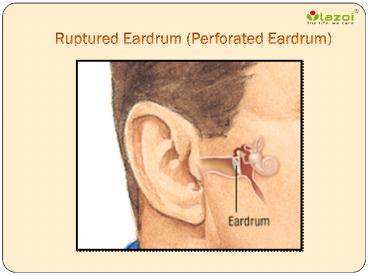Ruptured Eardrum (Perforated Eardrum): A sneak peek - PowerPoint PPT Presentation
Title:
Ruptured Eardrum (Perforated Eardrum): A sneak peek
Description:
Ruptured eardrum is a hole or tear in the skin-like tissue that separates the ear canal and middle ear. The eardrum is the part of the ear that receives vibrations from sound to allow hearing. Ruptured eardrums are most common in children. – PowerPoint PPT presentation
Number of Views:94
Title: Ruptured Eardrum (Perforated Eardrum): A sneak peek
1
Ruptured Eardrum (Perforated Eardrum)
2
Ruptured Eardrum (Perforated Eardrum)
- Ruptured eardrum is a hole or tear in the
skin-like tissue that separates the ear canal and
middle ear. The eardrum is the part of the ear
that receives vibrations from sound to allow
hearing. Ruptured eardrums are most common in
children.
3
Factors responsible for a ruptured eardrum
- Ear infection within the middle ear (acute otitis
media) - Injury to the side of the head as a result of a
sudden and forceful strike to the head - Sticking objects in the ear that travel too far
down in the ear canal and can puncture the
eardrum, such as a cotton swab or bobby pin - Sudden change in air pressure
- Skull fracture
- Loud noise caused by an explosion
4
Symptoms
- A ruptured eardrum is often caused by a middle
ear infection. With an infection fluid develops
behind the drum creating pain and discomfort.
This fluid build-up can create a small rupture of
the drum allowing fluid to drain from the ear,
appearing as pus. Bleeding may also occur. The
ruptured eardrum may also cause temporary hearing
loss as a result of the hole in the drum and the
drainage.
5
How is a ruptured eardrum diagnosed?
- An ENT specialist may identify holes or tears in
the eardrum by using various methods - Otoscope A lighted instrument used to view the
ear canal - Audiology exam A test that measures hearing and
ear drum mobility - Fluid sample Fluid may be taken if you
experience draining from the ear
6
Treatments
- Ear drops or oral medication (antibiotics) may
be prescribed. In most cases, healing of the
eardrum occurs within two months. Usually,
hearing loss (if any) lasts a short time. Some
rare complications of a ruptured
eardrum include - Long-term hearing loss
- Long-term vertigo
- Long-term dizziness
- Infection that can spread in the earIf an
eardrum does not heal after two months of
observation, an ENT specialist may perform a
simple repair called a myringoplasty to help aid
the healing process. This procedure is used to
repair small tears in an eardrum and consists of
a small patch placed in or on the hole. If the
tear does not heal properly or is taking too long
to heal, a surgery known as a tympanoplasty may
be required. Tympanoplasty is a more formal
procedure that repairs a damaged ear drum.
7
Treatments
Continue
- Care during treatment
- It is of the utmost importance that during your
treatment you do not get any water into the ear
canal. - You can use a cotton swab with Vaseline and take
a bath to ensure this. - You can also place a warm towel or heating pad
over the ear to reduce the discomfort and pain. - Do not clean your ears until your doctor says so.
This is also very important, as it can cause
damage during the healing process. - Avoid blowing your nose, as the pressure thus
created can affect the eardrum. - Ask your ENT doctor about which medicines you can
take to relieve the pain.
8
How to prevent a ruptured eardrum?
- First of all, avoid putting any foreign objects
into your ear - especially avoid pins or pointed
objects, as they will surely cause harm. - If you are suffering from a middle ear infection,
get treatment for it immediately. - You can protect your ears during a flight by
using pressure equalizing ear plugs or by chewing
gum during the ascent or the descent of the
flight. Also, if you have a cold or congestion,
avoid flying. - Protect your ears from loud noises. You can wear
ear plugs or ear muffs to do so. Reduce the
volume of the walkman, iPod, or the television.
Long term use of headphones must be avoided at
all costs.Proper care is necessary for any kind
of health disorder. If you experience any of the
symptoms above, get your condition treated by an
ENT doctor as soon as possible.
9
CONNECT WITH US
- Logon to
- www.lazoi.com
- Like us on Facebook
- https//www.facebook.com/LazoiTheLife
- Follow us on Twitter
- https//www.twitter.com/lazoithelife
- Follow us on Pinterest
- https//www.in.pinterest.com/lazoithelife

